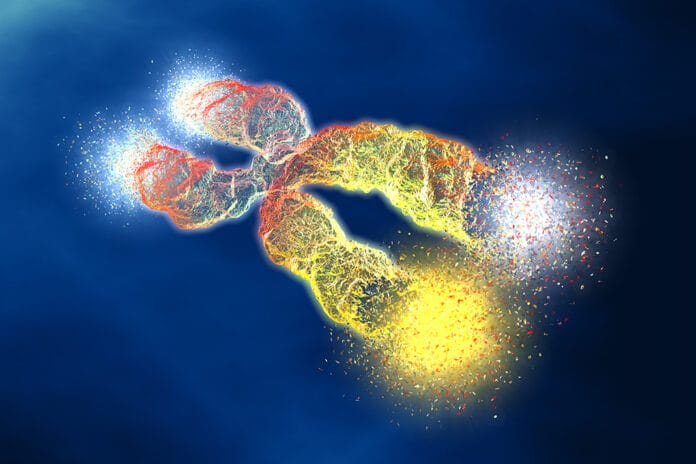When you hear about someone living into their 90s, you immediately think what a wonderful success of life. Isn’t longevity the goal? If you speak to many seniors living into their 90s, they may feel it’s not all that it’s cracked up to be. Many of us want to live a long life, enjoying our family and friends, but we would like it to be a healthy life and not a life filled with disease. If we had our druthers, we would most likely choose to have not only a long lifespan but also a long healthspan. It isn’t just quantity; it is all about quality.
The average life expectancy in the United States is 78.6 years for men and 81.1 for women.1
Some get lucky and trump those numbers and live long past the average expiration date. Why for some and not for others? Is it nature or nurture? Genes or environment?
The process of aging is complex, but if we glance into the genetic heart of the cell, we may find the answer. Telomeres are the repeating segments of noncoding DNA that live at the end of our chromosomes. Telomeres shorten with each cell division, helping determine how fast your cells age and when they die, depending on how quickly they wear down.
As a dental hygienist, if you think that you can’t affect someone else’s longevity or the length of their telomeres, you are mistaken. Not only in our operatories as a hygienist but as a human in our everyday lives, we can potentially affect other people’s life expectancy.
Telomeres
You say “poe-tae-toe” I say “po-ta-toe.” You say “tel-o-meer,” I say “teal-o-meer.” For a very long time, I said the word differently than the experts did. So, according to the powers that be, “teal-o-meer” is the way to go.
In 1961, Leonard Hayflick stumbled upon something called cellular senescence, or the death of a cell. Up until that point, there was a 60-year dogma that all cultured cells are immortal. What he figured out is that a cell divides around 50 to 70 times, and then they reach a stage called senescence.2 When too many of a person’s cells are senescent, your body’s tissues start to age.
If too many senescent cells are found in the walls of your blood vessels, for example, your arteries will stiffen, and you’re more likely to have a heart attack. Just as senescence refers to aging cells, immunosenescence describes the aging of cells that specifically support the immune system. This will diminish the ability of the immune system to respond to infections. The immune cells specifically affected are natural killer cells and T cells. When the infection-fighting immune cells in your bloodstream can’t tell when a virus is nearby because they’re senescent, you’re more susceptible to catch the flu or pneumonia.
Because of Leonard Hayflick’s discovery, now termed the Hayflick limit, scientists have learned so much about cellular aging. Hayflick did have his controversies but did great things for science, including being a founding member of the council of the National Institute of Aging. An interesting fun fact is that Hayflick’s father designed prosthetics for dental patients.
Telomeres are constantly listening to us. The way that we live effect tells our telomeres to speed up the process of cellular aging ─ the food you eat, your response to emotional challenges, the amount of exercise you get, whether you were exposed to childhood stress, and even the level of trust and safety in your neighborhood. Numerous studies compare poor sleep and shorter telomeres. In a 2019 study, research found people with severe obstructive sleep apnea had telomeres that indicated, on average, a 10-year acceleration of cellular aging.3
One of the keys to a long healthspan is for us simply do our part to foster healthy cell renewal.
Aging is the accumulation of damage, but telomeres, the protective end cap of chromosomes, help keep our cells youthful. As they protect your chromosomes day by day, they get shorter bit by bit. By the time you reach middle age, there can be a lot of telomere damage. You may notice wrinkles in the skin, and even the immune system is beginning to wear down.
Short telomeres affect all the classic ills of aging ─ heart disease, diabetes, Alzheimer’s, cancer, etc. A breakthrough in 1984 came in the discovery of an enzyme called telomerase that is found inside a cell that can help re-elongate telomeres keeping the protective sheaths around our chromosomes’ ends in good shape.
We can increase our telomerase naturally by reducing stress and engaging in mediation. Exercise, of course, is good for us, but specifically, yoga is beneficial and has been studied at length. Yoga also can reduce inflammation and protect us from oxidative damage.4 A low inflammatory diet and consuming antioxidants are also beneficial.
Clinical Care
A study from the University of Pittsburgh showed evidence that oxidative stress acts directly to hasten cellular aging.5 Oxidative stress is an imbalance between reactive oxygen species (ROS) production and the protective systems’ ability to detoxify these reactive products. It can cause damage to cells and tissues and then lead to chronic inflammation. Long-term oxidative stress can be harmful, causing damage to the proteins, cells, and DNA in the body. This can accelerate the aging process and create conditions such as chronic inflammation and neurodegenerative diseases, a detriment to human health.6
Periodontitis is an inflammatory disease of oxidative stress, and by treating our patient’s disease, we can have an influence to help reduce the effects.7
Research has shown that the pathogenesis of periodontal disease includes oxidative tissue damage. Periodontal disease is all about inflammation and the cascade of events and propensity for oxidative stress. Proinflammatory cytokines such as interleukin-1 (IL-1) IL-6 and tumor necrosis factor-α have a central role in periodontal tissue destruction.6 Relating periodontal disease and oxidative stress can then be directed to telomeres. A recent 2021 study had data that found a significant impact of periodontitis on decreasing telomere lengths across a life span.9
There are so many ways hygienists can help patients live a longer, healthier life. When we talk about diet, it is not only for oral health but could be for telomere health by recommending antioxidants, watching sugar intake, and increasing Omega-3 fatty acids. For example, if you pump a cell with vitamin C, the telomere is protected from free radicals.10 Vitamin E is also like a scavenger that gobbles up free radicals, protecting the cell.
Relationships
People who have relationships with kindness and mutual support tend to have better health. Socially isolated people are more stress reactive and depressed and are more likely to die earlier.11-13 Think about our patients who live alone (perhaps older), and we may be the only connection they have to a human in a week.
We can all become kinder and more understanding (and it will benefit us as well as others), trying to interconnect, reducing toxic stress, and specifically not to cause stress to others. Sadly, childhood trauma affects our telomere length as an adult. Biologic embedding is the name for the effects of childhood adversity that lodge themselves into the body.
When telomeres are measured in healthy adults, who were exposed to adverse childhood events, a dose-response relationship is often seen. The more traumatic events that a person experiences when they are younger, the shorter their telomeres as an adult.14 Keeping an eye out as we work with patients for physical and psychological well-being and safety is important ─ not just for the children but also for adults.
We can all practice being kinder to others inside and outside of the operatory. There is something called emotion contagion. The basic idea of emotion contagion holds that emotions of two or more people converge and are passed from person to person in larger groups. Steven Stosny, Ph.D., says, “Even low-grade defensive/aggressive states like resentment spread relentlessly from person to person. If someone comes into work resentful, by lunchtime, everyone around him or her is resentful. Aggressive drivers make other drivers aggressive. A hostile teenager ruins the family dinner; an impatient spouse makes TV-viewing tense and unpleasant.”
Meditation practices have had proven results for telomere lengthening, and simple meditation can often offset our reactions to adverse situations.
Research from Psychoneuroendocrinology found that loving-kindness meditation (LKM) has great benefits at a cellular level. LKM comes from the Vipassana Buddhist tradition and focuses on positive intentions, as well as unselfish kindness and warmth toward others. Research done in 2019 had two groups of participants doing two different meditation practices. One group did a six-week LKM workshop, and the other a mindfulness meditation workshop.
The LKM group helped cultivate warm and friendly feelings towards others, which is positive for others, but an added benefit was it helped themselves and their telomeres. Over 12 weeks, loving-kindness meditation buffered telomere attrition, telomere length decreased in the mindfulness group, and the control group and the LKM group showed less telomere attrition than the control group. Participants “showed no significant telomere shortening over time.”15
How do we slow down senescence today?
- Eating a healthy diet full of nutrients, we need to repair damage and fight off future damage.
- Reduce stress. Take up yoga or meditation to help combat stress.
- Avoid exposure to damaging substances such as UV light, pollutants, and toxins.
- Exercise more, building strong tissues.
- Prevent disease by seeing your doctor for routine checkups and keep your blood pressure, weight, and other risk factors under control.
- Stop smoking and encourage your patients to stop as well.
The ability we have as health care providers comes in different forms and fashions. This, too, is just another way we help our patients live longer and better lives. The value we add to patients’ lives is inspiring, and I am proud to be in such a wonderful group of providers.
Now Check Out the Self-Study, Peer-Reviewed CE Courses from Today’s RDH!
Listen to the Today’s RDH Dental Hygiene Podcast Below:
References
- Kochanek, K.D., Murphy, S.L., Xu, J.Q., Arias, E. Mortality in the United States, 2016. NCHS Data Brief, no 293. Hyattsville, MD: National Center for Health Statistics. 2017. Retrieved from https://www.cdc.gov/nchs/products/databriefs/db293.htm
- https://simple.wikipedia.org/wiki/Hayflick_limit
- Mathur, M.B., Epel, E., Kind, S., et al. Perceived Stress and Telomere Length: A Systematic Review, Meta-analysis, and Methodologic Considerations for Advancing the Field. Brain Behav Immun. 2016; 54: 158-169. doi:10.1016/j.bbi.2016.02.002 Retrieved from https://www.ncbi.nlm.nih.gov/pmc/articles/PMC5590630/
- Krishna, B.H., Keerthi, G.S., Kumar, C.K., Reddy, N.M. Association of Leukocyte Telomere Length with Oxidative Stress in Yoga Practitioners. J Clin Diagn Res. 2015; 9(3): CC01-CC3. doi:10.7860/JCDR/2015/13076.5729 Retrieved from https://www.ncbi.nlm.nih.gov/pmc/articles/PMC4413062/
- Fouquerel, E., Barnes, R.P., Uttam, S., et al. Targeted and Persistent 8-oxoguanine Base Damage at Telomeres Promotes Telomere Loss and Crisis. Molecular Cell. 2019; 75. Retrieved from https://www.cell.com/action/showPdf?pii=S1097-2765%2819%2930316-8
- Pizzino, G., Irrera, N., Cucinotta, M., et al. Oxidative Stress: Harms and Benefits for Human Health. Oxid Med Cell Longev. 2017; 2017: 8416763. doi:10.1155/2017/8416763 Retrieved from https://www.ncbi.nlm.nih.gov/pmc/articles/PMC5551541/
- Sa Carneiro Sczepanik, F., Lima Grossi, M., Casati, M., et al. Periodontitis is an Inflammatory Disease of Oxidative Stress: We Should Treat It that Way. Periodontol 2000. 2020 Oct; 84(1): 45-68. doi: 10.1111/prd.12342. PMID: 32844417. Retrieved from https://pubmed.ncbi.nlm.nih.gov/32844417/
- Nikolopoulos, G.K., Dimou, N.L., Hamodrakas, S.J., Bagos, P.G. Cytokine Gene Polymorphisms in Periodontal Disease: A Meta-analysis of 53 Studies Including 4178 Cases and 4590 Controls. J Clin Periodontol. 2008 Sep; 35(9): 754-67. doi: 10.1111/j.1600-051X.2008.01298.x. Epub 2008 Jul 31. PMID: 18673406. Retrieved from http://www.ncbi.nlm.nih.gov/pubmed/18673406
- Nguyen, L.M., Chon, J.J., Kim, E.E., Cheng, J.C., Ebersole, J.L. Biological Aging and Periodontal Disease: Analysis of NHANES (2001-2002). JDR Clin Trans Res. 2021 Feb 19:2380084421995812. doi: 10.1177/2380084421995812. Epub ahead of print. PMID: 33605165. Retrieved from https://pubmed.ncbi.nlm.nih.gov/33605165/
- Adelfalk, C., Lorenz, M., Serra, V., von Zglinicki, T., Hirsch-Kauffmann, M., Schweiger, M. Accelerated Telomere Shortening in Fanconi Anemia Fibroblasts–A Longitudinal Study. FEBS Lett. 2001 Sep 28; 506(1): 22-6. doi: 10.1016/s0014-5793(01)02869-1. PMID: 11591364. Retrieved from https://pubmed.ncbi.nlm.nih.gov/11591364/
- House, J.S., Landis, K.R., Umberson, D. Social Relationships and Health. Science. 1988 Jul 29; 241(4865): 540-5. doi: 10.1126/science.3399889. PMID: 3399889. Retrieved from https://pubmed.ncbi.nlm.nih.gov/3399889/
- Berkman, L.F., Syme, S.L. Social Networks, Host Resistance, and Mortality: A Nine-year Follow-up Study of Alameda County Residents. Am J Epidemiol. 1979 Feb; 109(2): 186-204. doi: 10.1093/oxfordjournals.aje.a112674. PMID: 425958. Retrieved from https://pubmed.ncbi.nlm.nih.gov/425958/
- Holt-Lunstad, J., Smith, T.B., Baker, M., Harris, T., Stephenson, D. Loneliness and Social Isolation as Risk Factors for Mortality: A Meta-analytic Review. Perspect Psychol Sci. 2015 Mar; 10(2): 227-37. doi: 10.1177/1745691614568352. PMID: 25910392. Retrieved from https://pubmed.ncbi.nlm.nih.gov/25910392/
- Chen, S.H., Epel, E.S., Mellon, S.H., Lin, J., Reus, V.I., Rosser, R., Kupferman, E., Burke, H., Mahan, L., Blackburn, E.H., Wolkowitz, O.M. Adverse Childhood Experiences and Leukocyte Telomere Maintenance in Depressed and Healthy Adults. J Affect Disord. 2014 Dec; 169: 86-90. doi: 10.1016/j.jad.2014.07.035. Epub 2014 Aug 5. PMID: 25173430; PMCID: PMC4172492. Retrieved from https://pubmed.ncbi.nlm.nih.gov/25173430/
- Le Nguyen, K.D., Lin, J., Algoe, S.B., Brantley, M.M., Kim, S.L., Brantley, J., Salzberg, S., Fredrickson, B.L. Loving-kindness Meditation Slows Biological Aging in Novices: Evidence from a 12-week Randomized Controlled Trial. Psychoneuroendocrinology. 2019 Oct; 108: 20-27. doi: 10.1016/j.psyneuen.2019.05.020. Epub 2019 May 20. Retrieved from https://pubmed.ncbi.nlm.nih.gov/31185369/












